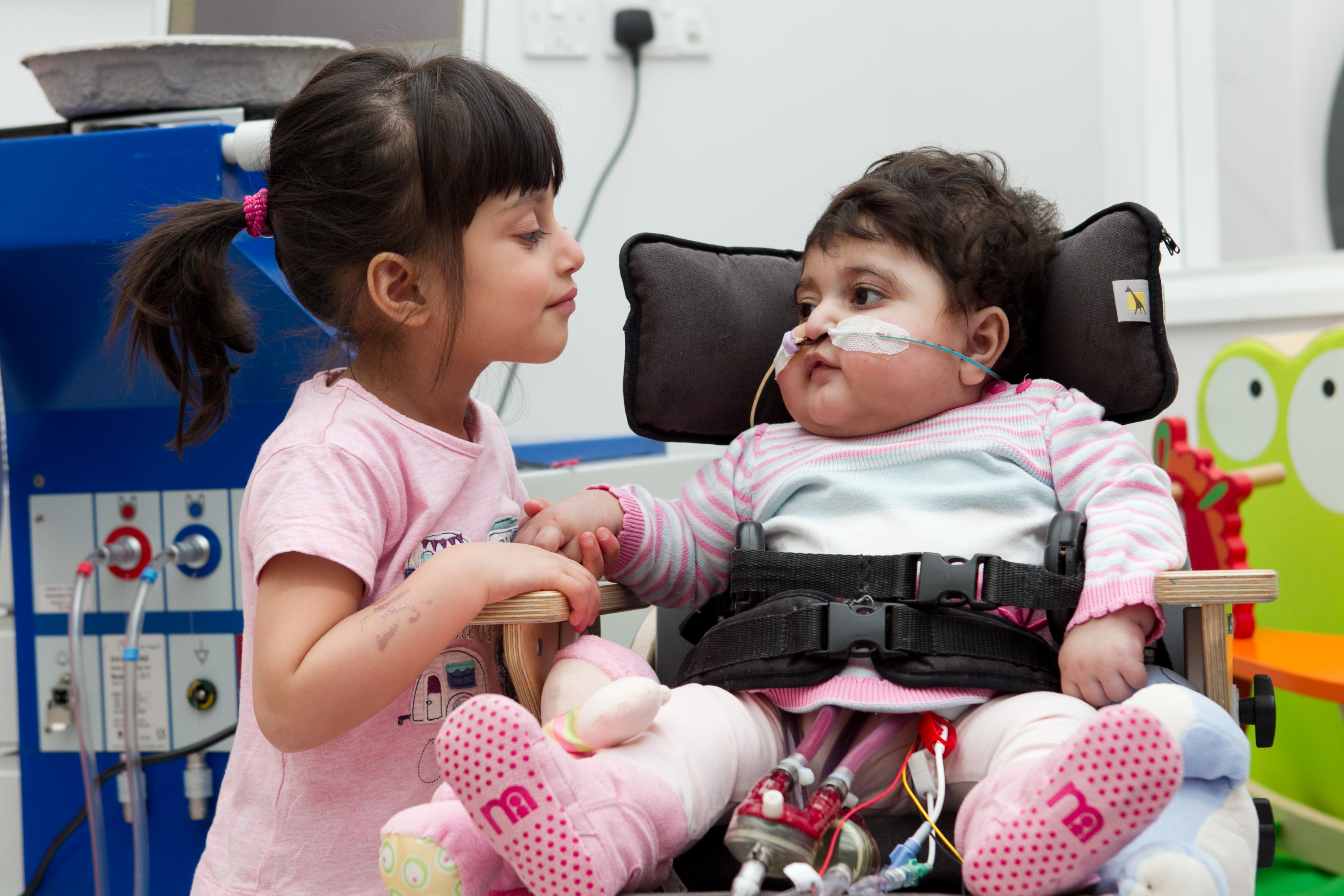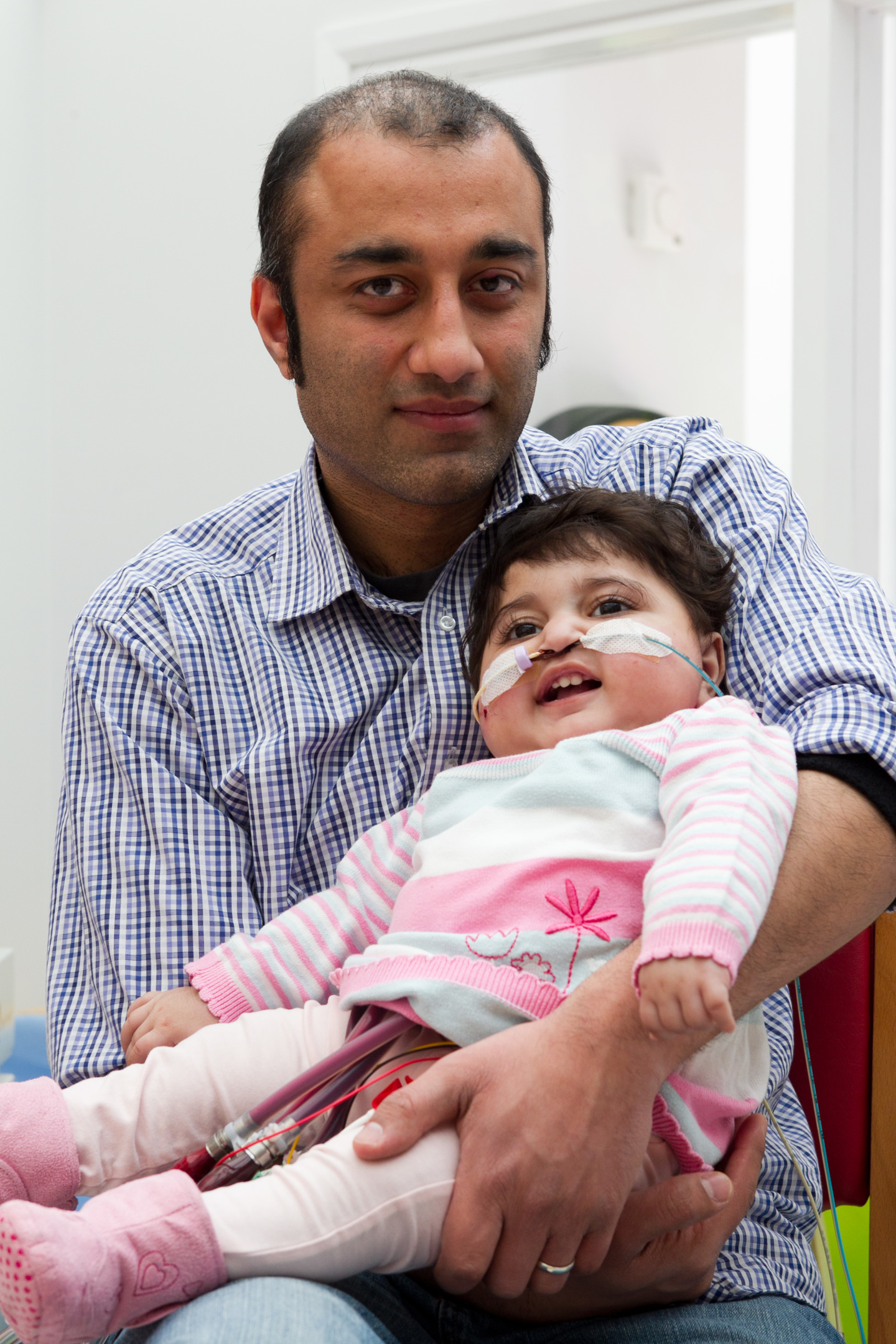
Fourteen-month-old Khadija Khalil’s health deteriorated after she caught flu, age four months. Now she has an artificial heart machine which beats outside her body.
It means when parents Maria, 27, and dad Usmaan, 33, want to take her for a walk, they have to bring the device with them, trundling it along next to Khadija’s pram.
The 14-stone miracle machine – which is known as a Berlin heart and looks to the untrained eye like a photocopier machine – is used by children whose hearts are no longer strong enough to pump blood around their bodies.
It can never leave Khadija’s side as it works day and night to keep her alive until she gets a heart transplant.
Maria said the device had allowed the family a degree of normality during a nightmare period, including all-important strolls out of the hospital where the heart accompanied them.
“The mechanical heart does give our little girl the chance of a normal life,” Maria said.
“However, it was not how we imagined it would be.
“No parent ever does.
“But this is our daughter’s life while she waits desperately for a heart transplant.”
Usmaan described the joy of stepping out of hospital for the first time three weeks ago, with the mechanical heart-on-wheels in tow.
“We were not allowed to leave hospital for months because Khadija was not strong enough to cope with winter and the chilly spring.
“When the doctors told us we could venture out, we were delighted.
“It means me pushing the Berlin heart but that’s how it has to be at the moment.
“You learn to accept and value the moments you can take a walk with your children.”
Khadija is believed to be the youngest of six children in the UK currently being kept alive by one of the German-made devices, which are driven by compressed air.
She even celebrated her first birthday in February with a cake perched on her bed next to her Berlin heart.
The device has quickly been incorporated into the family’s routine.
Khadija was a healthy child until after she caught flu at four months.
“We had tried to feed Khadija some milk to settle her for her afternoon nap,” recalled Usmaan, an IT support analyst from Edinburgh.
“However, within 15 minutes she woke screaming and we tried to comfort her.
“Nothing would settle her.
“The next thing we knew was that she was gasping for breath and her little body went limp.”
When paramedics arrived at the family home they discovered her tiny heart was racing at 170 beats per minute, 30 beats above the maximum for a baby her age.
Usmaan and Maria could only look on helplessly as the paramedic team did their best to stabilise her.
“When her heartbeat rose to 190 we were terrified,” Usmaan continued.
“By the time she reached Edinburgh’s Sick Children’s Hospital it had soared to 220.
“We could only hope and pray that the medical team could help her before the worst happened.
“She was so young, vulnerable and dangerously ill.”
Drugs failed to slow down Khadijah’s racing heart so paediatricians used a defibrillator to try to shock it into a normal beat.
“That helped a bit but not enough to take her out of danger,” Usmaan added.
“She was then transferred to the Hospital for Sick Children in Glasgow.”
Throughout the 42-mile journey the desperately ill baby was paralysed and linked up to a myriad of wires and machines.
But when cardiac specialists tried to bring her out of her paralysed state over the course of a day her heart soared to 230 beats a minute.
Doctors quickly paralysed her again in a desperate attempt to calm her heart.
Scans showed it had enlarged to three times its normal size and was badly damaged.
“A decision was made to get her down to the transplant team at Newcastle’s Freeman Hospital as soon as possible,” Usmaan said.
“We were heartbroken about what had happened to our lovely baby girl.
“Only weeks earlier she had been a thriving baby.”
Within days Khadija underwent an eight-hour operation to fit her with her Berlin heart.
“We are so glad to have it because it keeps Khadija alive,” said Maria, also mum to Alisha, three.
But other milestones in Khadija’s life, like walking, have not been reached yet.
“She has endured so much in her little life and still manages to smile away.
“She is an inspiration to us all,” said Maria, smiling.
Worrying wait for a little donor
THE family is locked in a race against time to find a suitable donor.
“Khadija will only get a transplant if another infant her age or slightly older passes away,” said Usmaan.
“We fully understand the heartbreak that will mean to the donor’s family.
“Maria and I have signed donor cards because we want to pass on the gift of life.
“Our little one’s very future depends on the kindness of strangers.”
The family are being supported by the Sick Children’s Trust.
It helps families, providing accommodation for relatives of people facing long hospital stays.
“The cost of staying in a hotel for nine months would stretch any family’s budget to breaking point,” said Usmaan.
“Being able to live only minutes from Khadija’s ward means we can see her any time.
“The stress of having a very ill child is enormous and we are eternally grateful to have a home from home.”
Vital tool that saves lives
THE Berlin heart is a device which can be used in people whose own are not strong enough to pump enough blood around their bodies.
It buys valuable time for severe cardiac failure patients until a donor heart can be found.
The device is an air-driven pump which takes over the work of the person’s own heart.
It can be used to work of one or both sides of the organ.
The machinery consists of a plastic chamber which sits outside the body.
It has a blood-filled side and an air-filled one. The blood-filled side of the pump is connected directly to the child’s own heart and main artery by two tubes.
Patients cannot remain on it indefinitely. The longest an infant has spent on the mechanical heart is 877 days.
Developed by Berlin-based experts, the devices have helped approximately 1,000 children worldwide over the last two decades.
READ MORE
Smiles better: Five-year-old Donald fights back after flu left him in a coma
Quick-thinking nurse saved singer having a heart attack on stage

Enjoy the convenience of having The Sunday Post delivered as a digital ePaper straight to your smartphone, tablet or computer.
Subscribe for only £5.49 a month and enjoy all the benefits of the printed paper as a digital replica.
Subscribe